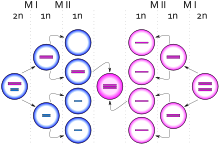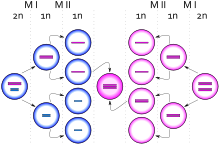- Triple X syndrome
-
Triple X syndrome Classification and external resources ICD-10 Q97.0 DiseasesDB 13386 Triple X syndrome is a form of chromosomal variation characterized by the presence of an extra X chromosome in each cell of a human female. The condition always produces females, with an XX pair of chromosomes, as well as an additional chromosome, resulting in the formation of XXX. A mosaic form also occurs where only a percentage of body cell contain XXX while the remainder carry XX. The extent to which an individual is affected by the condition will depend upon the proportion of XXX to XX throughout. [1] The condition is also known as triplo-X, trisomy X, XXX syndrome, and 47,XXX aneuploidy. Triple X results during division of a parent's reproductive cells and occurs about once in every 1,000 female births. Unlike most other chromosomal conditions (such as Down syndrome), there is usually no distinguishable difference to the naked eye between women with triple X and the rest of the female population.
Contents
Cause
Triple X syndrome is not inherited, but usually occurs as an event during the formation of reproductive cells (ovum and sperm). An error in cell division called nondisjunction can result in reproductive cells with additional chromosomes. For example, an oocyte or sperm cell may gain an extra copy of the X chromosome as a result of the non-disjunction. If one of these cells contributes to the genetic makeup of a child, the child will have an extra X chromosome in each of her cells. In some cases, trisomy X occurs during cell division in early embryonic development.
Some females with triple X syndrome have an extra X chromosome in only some of their cells. These cases are called 46,XX/47,XXX mosaics.
Symptoms
Because of the lyonization, inactivation and formation of a Barr body, in all female cells, only one X chromosome is active at any time. Thus, Triple X syndrome most often causes no unusual physical features or medical problems. But there are rare cases when a female with Triple X syndrome is affected by changes such as tall stature, behavioral problems, clumsiness, poor coordination, midfacial hypoplasia, wide-set eyes, epicanthic fold, amenorrhea, posteriorly rotated ears, small head, long head, small lower jaw, expressionless face, prominent forehead, enamel hypoplasia, widely spaced nipples, small hands, small feet, kyphosis, lordosis, reduced muscle tone, ovarian failure, mental retardation, and infertility. [2] Females with the condition may have menstrual irregularities and, although rarely exhibiting severe mental impairments, have an increased risk of learning disabilities, delayed speech, deficient language skills and delayed development of motor skills.
There are seldom any observable physical anomalies in Triple X females, other than being taller than average. Most women with Triple X have normal sexual development. Some experience an early onset of menstruation. Triple X women are rarely diagnosed, apart from pre-natal testing methods, unless they undergo amniocentesis and blood tests for medical reasons later in life. Most medical professionals do not regard the condition as a disability. However, if mild delays are present, such status can be sought by parents for early intervention treatment.
Incidence
Triple X syndrome occurs in around 1 in 1,000 girls. On average, five to ten girls with triple X syndrome are born in the United States each day.[3]
First case
The first published report of a woman with a 47,XXX karyotype was by Patricia A. Jacobs, et al. at Western General Hospital in Edinburgh, Scotland, in 1959. It was found in a 35‑year-old, 5 ft. 9 in. (176 cm) tall, 128 lb. (58.2 kg) woman who had premature ovarian failure at age 19; her mother was age 41 and her father was 40 at the time of her conception.[4]
Statistics
In Denmark between 1970-1984 76% of the prenatally diagnosed fetuses with triple-X were aborted. Between 1985-1987 this figure dropped to 56%. With improved information the number of abortions diminished. The experience in the Netherlands demonstrates that during the period 1991-2000 33% (18/54) of the couples that were confronted with a prenatal diagnosis of 47,XXX elected to abort. If balanced information is provided to prospective parents, pre-natally, the incidence of voluntary termination (abortion) is reduced.[5]
See also
- Klinefelter syndrome
- XYY syndrome
- Turner syndrome
- XXXX syndrome
- XXXXX syndrome
References
- ^ Medical text written August 2002 by Contact a Family. Last reviewed February 2008 by Dr R Stanhope, Consultant Paediatric Endocrinologist, Institute of Child Health, London, UK. http://www.cafamily.org.uk/medicalinformation/conditions/azlistings/t40_1.html
- ^ http://www.wrongdiagnosis.com/symbol/47_xxx_syndrome/symptoms.htm
- ^ National Library of Medicine (2007). "Genetics Home Reference: Triple X syndrome". http://ghr.nlm.nih.gov/condition=triplexsyndrome. Retrieved 2007‑03‑22.
- ^ Jacobs PA, Baikie AG, Brown WM, MacGregor TN, Maclean N, Harnden DG (September 26, 1959). "Evidence for the existence of the human "super female"". Lancet 274 (7100): 423–5. doi:10.1016/S0140-6736(59)90415-5. PMID 14406377. http://www.sciencedirect.com/science?_ob=ArticleURL&_udi=B6T1B-49JVK1P-NW&_user=10&_coverDate=09%2F26%2F1959&_rdoc=1&_fmt=&_orig=search&_sort=d&view=c&_acct=C000050221&_version=1&_urlVersion=0&_userid=10&md5=9ff3228399f35afd36bda605db23eb23.
- ^ written by Connie T.R.M. Schrander-Stumpel, MD, PhD, Professor of Clinical Genetics, Academic Hospital Maastricht, Netherlands. http://www.triple-x-syndroom.nl/document31/patient+care+article+triplexsyndrome+or+trisomy+x
External links
- NLM (2007). Triple X syndrome Genetics Home Reference
- Guy's Hospital Clinical Genetics Department (2001). Triple X information leaflet
- Nielsen, Johannes (1998). Triple-X Females. An Orientation. The Turner Center, Aarhus Psychiatric Hospital, Risskov, Denmark.
- Triple X information booklet by Dr. Nielsen, a psychiatrist and geneticist who led the longest running of 8 international newborn screening studies of sex chromosome abnormalities.
Categories:- Sex chromosome aneuploidies
- Syndromes
Wikimedia Foundation. 2010.


